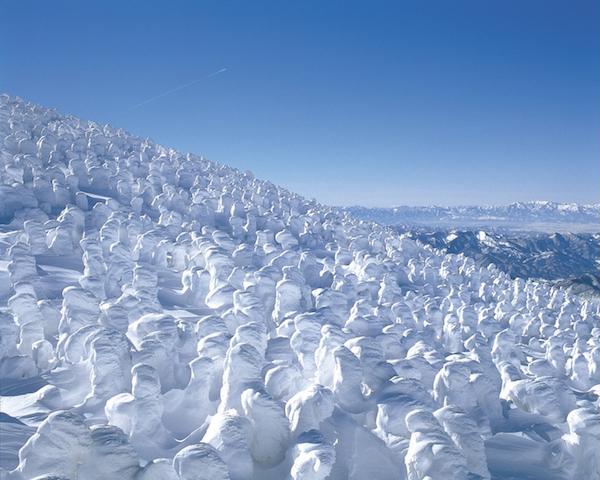What is the precious, natural phenomenon of ice trees?
Ice trees, known as 'Juhyo', are created when super cooled water droplets that are below freezing point hit the Coniferous trees known as Aomori Todomatsu and freeze instantly.
The precise and harsh conditions needed to create them make this a sight that can only be seen in a limited number of areas, even in Japan.
The easiest place to see them is Zao, where all you have to do is ride a ropeway to meet these ice monsters.
Aim for the summit on the Zao ropeway!
To see the ice trees, head from Sanroku Station (855m) to Juhyo-kogen Station (1,331m) where you make a transfer and head for Jizo Sancho Station (1,661m).
Ice trees are visible from the window of the ropeway carriage as soon as it departs from Juhyo-kogen Station.
As you will be able to tell from the section below about which conditions are needed for ice trees to form,
the winter weather on Zao’s summit is often extremely severe with strong winds and snow.
We recommend visiting with the equipment you would use for skiing or climbing a snowy mountain!
At last, face to face with the ice monsters
Once you get off the ropeway at the summit, you will be in the snow monster’s country.
Step out of the ropeway station and the snow monsters will appear in front of you.
Pillars of snow 4 - 5m in height bow their heads due to the weight, making them look like frozen monsters.
The sight creates a huge impact.
How are the ice trees made?
These pillars of snow take a long time to create.
First, snow starts to fall around November time and the snow begins to stick to the Aomori Todomatsu, coniferous trees found on the mountain,
with the layers of snow growing bigger in January and reaching their peak in February.
In March, the temperature begins to rise and they become smaller again, collapsing all at once.
The ice trees are often seen pictured grouped together and spreading out before your eyes under a blue sky.
However, this is a truly rare scene.
Winter along the Sea of Japan often brings bad weather with cloudy skies and heavy snow making visibility poor,
so please remember that this is a difficult sight to actually see.
Those who do manage to see the ice trees under a blue sky can be proud of the luck they have had.
However, the sight of the snow monsters hiding and appearing from amongst the blowing snow is also powerful and there is nothing else quite like it,
so it is definitely worth visiting once.
Also worth visiting is the fantastic light up
Every year, there is an evening light up (17:00 – 21:00) which takes place from early December to the start of March.
The atmosphere is completely different to the daytime and worth seeing as it makes you feel like you are lost in a world of illusions.
But, the night times are even colder so visitors must take the proper precautions against the cold!
Extra information: What conditions are needed for ice trees?
① (From the Japan Sea) wet wind and snow coming in from one direction
② Plants which snow can easily stick to, like the Aomori Todomatsu
③ The right amount of snow (too much and the tree will be buried)
 JAPAN Travel Concierge
JAPAN Travel Concierge

